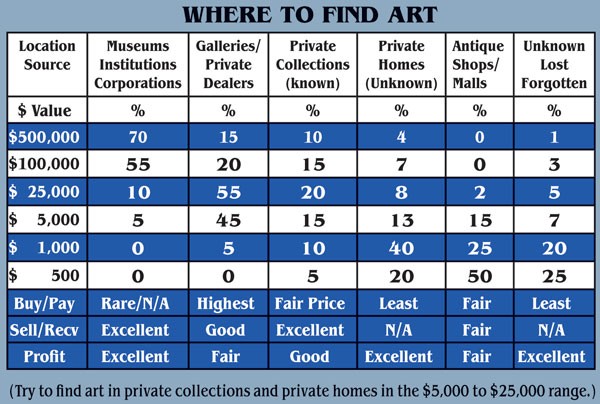How to Buy and Sell Art for a Profit
Post on: 15 Май, 2015 No Comment

Above: Example Investment Art: This painting by Herman Herzog (1832-1932) is representative of Investment Art. Herman Herzog (American/German) is a painter of considerable accomplishment, and any oil painting by him, in good to excellent condition, is highly sought after, and will always increase in value. This painting, Cows in a Pennsylvania Landscape, might fetch $10,000 at auction. A painting by Herman Herzog in a Mountain Landscape, for which he is best known, could be worth $20,000, and one of his rare Florida landscape could even be worth $50,000. Herman Herzog meets our criteria for Investment Art.
by: Ron Davis
As seen in Antiques & Art Around Florida, Winter/Spring 2006
Investing in art is not a get-rich quick scheme. But for many people, buying and selling art is more lucrative than other investments, and many have built a solid, growing, and rewarding business in art.
THE THREE BUYERS OF ART
First, decide what roll you want to play, whether you want to be an Art Collector, Investor, or Dealer, because each has a different motivation, buying and selling strategy, and outcome objective. The collector buys what he likes. the investor what he needs, and the dealer what he can sell for the highest price in the shortest amount of time. Each needs to follow the strict buying criteria outlined below.
The Collector has a love for art but not a compelling schedule to buy it. He buys only what pleases him, without regard for what’s hot, possibly buying only one painting a year. The collector has no exit strategy or financial objective in mind when he buys art. He well might keep a painting all his life, willing it to his children or a museum. The art he buys, however, should create future wealth for his family. The collector also needs to acquire art knowledge and competent buying skills so he is not taken advantage of. Serious collectors usually have a focus and narrow interest in a particular School. Always studying art they like, collectors often become subject experts in their specialty.
The Investor definitely has an exit strategy and outcome objective in mind when he buys art. Developing a financial plan, the Investor buys art strategically, according to the strict criteria listed below, doing extensive research to eliminate risks associated with buying art. The Investor’s time frame is five to seven years out. A weak economy will peak again in five to seven years. Even an unfresh painting (recently bought at public auction, or one shopped around) will be fresh again in five to seven years. The investor buys what collectors desire, insuring him of a quick sale when it’s time to cash in. The Investor expects 25% ROI, but even higher returns can be made with art.
The Dealer’s business is buying and selling paintings, and brokering art transactions. Like any business owner, the dealer is on the telephone every day talking with customer and suppliers: collectors, investors, galleries, auction rooms, and other dealers. When an exceptional painting comes to market, the dealer pursues it relentlessly. The dealer’s time frame is measured in days or weeks, rarely months, generally selling at the highest price in the shortest amount of time. Because he buys only investment art, there is always a demand for his paintings. If you’re a seller, on the other hand, selling art to a dealer can be an expensive proposition, because he’ll only resell your painting right away, to a collector, investor, or gallery, for a handsome profit, exactly what you could have done, if you only knew what the dealer knows. So it behooves the collector to learn the parallel skills of an art dealer.














